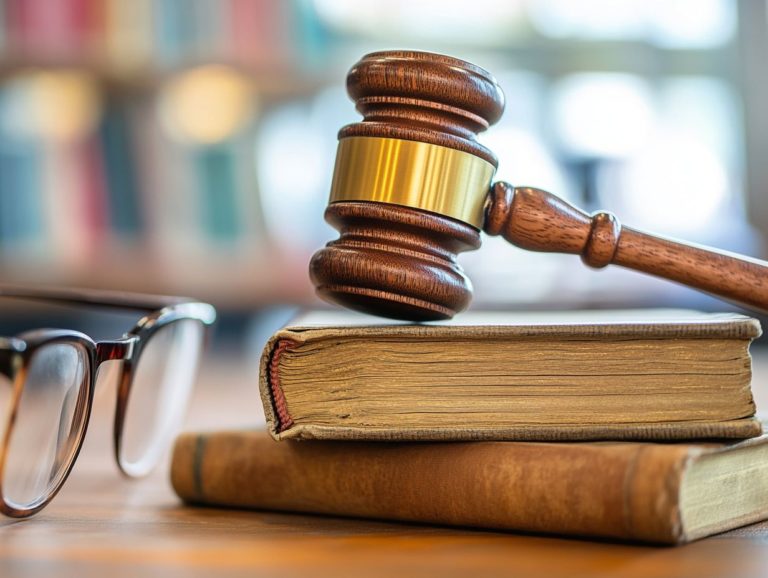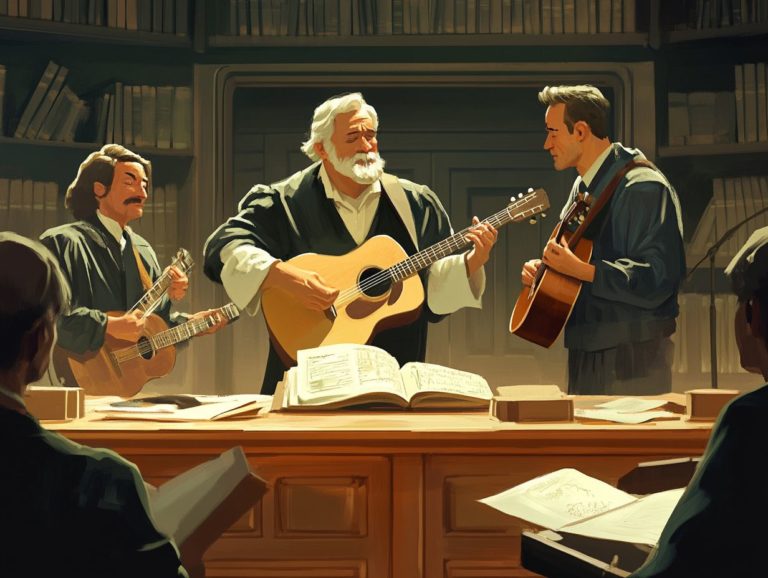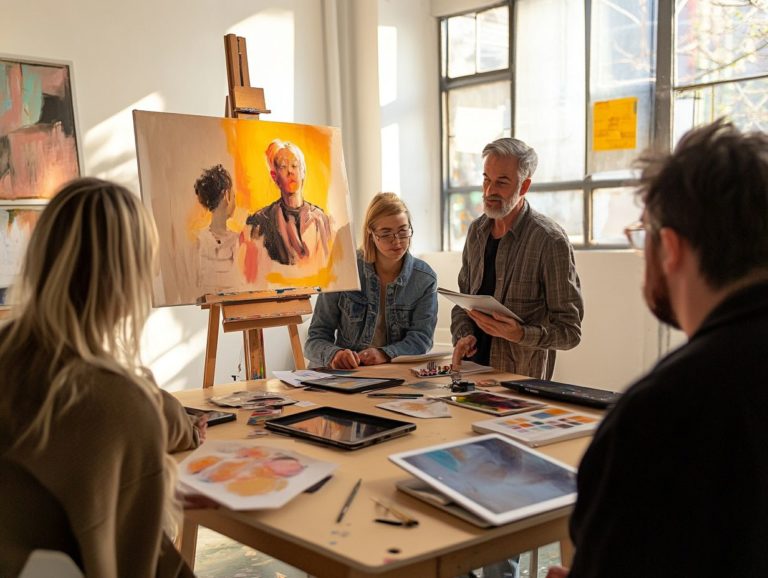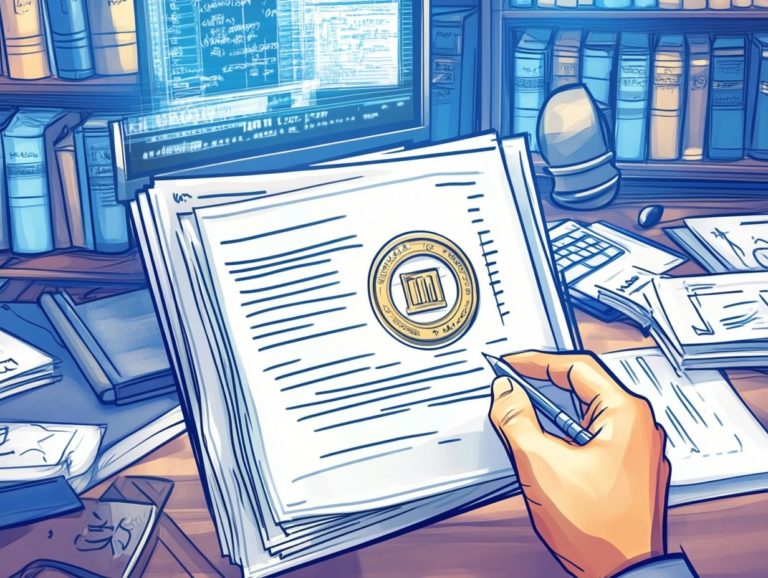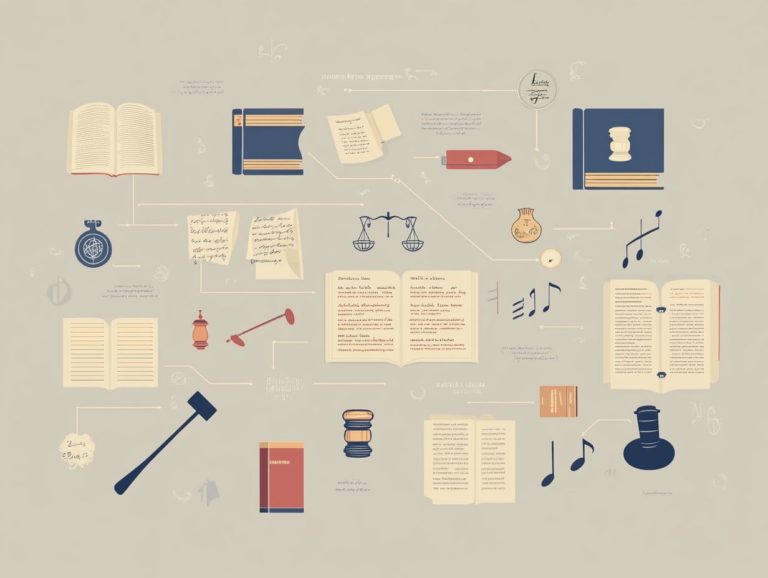5 Ways to Avoid Copyright Issues on Social Media
Navigating the intricate landscape of social media can be a challenge, especially regarding copyright laws. With the effortless sharing of content, many users may inadvertently risk infringing on the rights of others.
This guide presents five essential strategies that empower you to create and share content responsibly. By understanding fair use and using royalty-free resources, you can protect your online presence while honoring the hard work of original creators.
Elevate your social media game and sidestep copyright pitfalls!
Contents
- Key Takeaways:
- 1. Understand Copyright Laws and Fair Use
- 2. Create Original Content
- 3. Use Royalty-Free Images and Music
- 4. Give Proper Credit to Original Creators
- 5. Obtain Permission Before Using Others’ Content
- What Are the Consequences of Copyright Infringement on Social Media?
- How Can Businesses Protect Themselves from Copyright Issues on Social Media?
- What Are the Most Common Copyright Mistakes on Social Media?
- How Can One Determine If a Post Is Infringing on Copyright?
- What Are the Alternatives to Using Copyrighted Content on Social Media?
- What Are the Best Practices for Avoiding Copyright Issues on Social Media?
- Frequently Asked Questions
Key Takeaways:
- Know copyright laws and fair use to avoid legal issues.
- Create original content to avoid using others work.
- Use royalty-free images and music for safe content creation.

1. Understand Copyright Laws and Fair Use
Understanding copyright laws and fair use is essential for content creators navigating the world of digital rights. With platforms like YouTube, TikTok, and Instagram booming, original content is shared widely, often without the necessary consent.
Copyright laws vary by region and influence how you manage your work. For example, in the US, the fair use doctrine allows you to use copyrighted material under specific conditions without seeking permission.
In contrast, the UK follows fair dealing, which is generally more restrictive. Australia has provisions resembling both approaches, while India s copyright regulations reflect its cultural context. Singapore aims to protect both creators and public interest.
Sharing content on social media requires knowing the difference between inspiration and infringement. Engaging with legal firms like Kelley Gordon and Marshall Gerstein & Borun can provide invaluable insights, helping you navigate potential pitfalls while respecting others’ rights.
2. Create Original Content
Creating original content is essential for building your brand and avoiding copyright pitfalls tied to using third-party content without proper licensing. This protects you legally and helps carve out a distinct identity in a crowded marketplace.
By developing unique creative assets, you can connect more deeply with your audience and reinforce your brand values. Collaborating with others can spark innovative ideas and foster a sense of community.
Tapping into user-generated content (UGC) is a powerful strategy to elevate your brand’s visibility. UGC nurtures authentic connections and showcases real customer experiences, making your brand more relatable and trustworthy.
3. Use Royalty-Free Images and Music
Using royalty-free images and music is a smart strategy, allowing you to enhance your content while minimizing copyright risks. These are resources you can use without paying fees.
Choosing royalty-free options gives you access to high-quality visuals and audio without hefty licensing fees. Creative Commons is a licensing system that allows for sharing and use of creative works, while public domain materials are available at no cost.
Platforms like Unsplash and Pixabay offer extensive libraries of royalty-free images, while Free Music Archive and Pixabay Music provide a rich assortment of musical options.
By adhering to specific licensing agreements, you promote ethical use and protect yourself from potential legal issues, paving the way for innovative and compliant creative endeavors.
Start exploring royalty-free resources today to protect your content!
4. Give Proper Credit to Original Creators

Giving credit to original creators is essential. It upholds copyright policies and nurtures respect and collaboration within the vibrant content creation community, especially on social media.
When you acknowledge the work of others, you help cultivate a culture of appreciation that sparks creativity among your peers.
For instance, on platforms like Instagram, tagging the original creator in your post or story is a straightforward yet powerful way to promote transparency. On Facebook, sharing a post while giving credit highlights the source and provides valuable context for your audience.
YouTube creators often cite their inspirations in video descriptions, guiding viewers toward more content to explore. These practices honor the contributions of creators and enhance the integrity of online interactions. This aligns with fair use principles.
5. Obtain Permission Before Using Others’ Content
Always get permission before using someone else’s content. This step helps you avoid copyright infringement and ensures compliance with licensing agreements.
You might consider various methods to secure this permission, such as using content release forms that document consent from the original creator. This formal approach adds clarity and protects you from potential disputes in the future.
Engaging directly with creators can foster stronger relationships and lead to collaborations that benefit both parties. This dialogue is especially important in brand collaborations, where sharing content often requires explicit approval to maintain compliance and uphold brand integrity.
By navigating these avenues thoughtfully, you can enhance your projects while respecting the rights of others.
What Are the Consequences of Copyright Infringement on Social Media?
The consequences of copyright infringement on social media can be severe, with repercussions ranging from legal actions and hefty fines to potential damage to your reputation as a brand or content creator.
Platforms like YouTube and Instagram are vigilant about enforcing copyright rules. Just one instance of unauthorized use could lead to account suspensions or even permanent bans, limiting your ability to connect with your audience.
Potential lawsuits not only come with financial penalties but can also drag you into long legal battles, distracting you from your content creation.
Knowing copyright laws helps you avoid problems and ensures you remain compliant with all regulations.
How Can Businesses Protect Themselves from Copyright Issues on Social Media?
Protect your business with smart strategies! Establish strong copyright policies, utilize licensing agreements, and keep a proactive legal team on hand to manage copyright risks effectively.
To bolster your protective measures, draft clear copyright policies that detail the permissions and restrictions tied to content usage. Obtaining content release forms from creators can shield you from potential disputes, ensuring everyone is aligned on rights and responsibilities.
Having a dedicated legal team is essential. They can offer ongoing consultation and training to help you navigate the complexities of copyright law. Use these strategies to greatly reduce the risk of copyright issues and create a more secure, compliant content-sharing environment.
What Are the Most Common Copyright Mistakes on Social Media?

Common copyright mistakes on social media often arise from accidentally using someone else’s content without the necessary permissions. This can lead to copyright infringement and serious legal issues.
Many content creators might think that simply attributing the source is enough to avoid problems. However, that s not always the case. Each piece of user-generated content (UGC) carries its own set of usage rights that must be respected.
To navigate these complexities, always seek explicit permission from original creators before sharing their work. Leveraging platforms that provide UGC licenses can help ensure compliance and promote respectful collaboration within the creative community.
Take action now to protect your integrity by researching and following copyright laws. This not only safeguards your own work but also shows respect for the content you share.
How Can One Determine If a Post Is Infringing on Copyright?
Determining whether a post infringes on copyright requires assessing several factors, including the nature of the content, its potential for fair use, and whether any copyright registration or Digital Rights Management (DRM) controls are in place.
To evaluate potential infringement, consider the purpose and character of the use, especially if it s transformative. This aspect is crucial in fair use determinations. For example, in the case of Campbell v. Acuff-Rose Music, Inc., the Supreme Court ruled that a parody could qualify as fair use.
You can check copyright registration through the U.S. Copyright Office’s online database, which provides records about ownership. Familiarizing yourself with DRM, which controls how digital content can be used, will help you understand if content is protected by specific access controls.
What Are the Alternatives to Using Copyrighted Content on Social Media?
Alternatives to using copyrighted content on social media include sourcing royalty-free images, utilizing Creative Commons materials, and creating original content that resonates with your audience.
By exploring platforms that offer royalty-free images and music, you can discover options that elevate your content without legal worries.
Creative Commons licenses allow you to share and remix works while giving proper credit to the original creators. This fosters a vibrant creative community and encourages diverse expressions in your marketing efforts.
User-generated content (UGC) can be an excellent source of inspiration, providing unique visuals that genuinely connect with your viewers without infringing on copyright.
Through these avenues, your social media engagement can expand, opening up a world of innovative choices just waiting to be explored.
What Are the Best Practices for Avoiding Copyright Issues on Social Media?
Adopting best practices to avoid copyright issues on social media is essential for content creators. This means understanding copyright policies, obtaining necessary permissions, and creating original content.
In addition to these steps, regularly review current copyright laws to stay informed about any changes that might affect your work. Utilizing content release forms can streamline rights acquisition and ensure that everyone is on the same page.
Maintaining clear communication with original creators fosters a collaborative environment and reduces the risk of unintentional infringement.
By implementing these actionable strategies, you can protect your creative works while respecting the intellectual property of others.
Frequently Asked Questions

Copyright issues on social media occur when someone uses copyrighted material without permission from the owner. This can include images, videos, music, or written content.
Avoid copyright issues by using royalty-free images or creating your own content.
Always source and credit others correctly, obtain permission, and understand fair use laws.
Copyright issues can lead to legal trouble, harm your reputation, and damage your brand.
What is fair use?
Fair use lets you use limited copyrighted material without permission, mainly for commentary, teaching, or research.
However, fair use can be tricky and may cause problems if not applied correctly.
Can I use copyrighted material if I give credit to the owner?
Just giving credit doesn’t make it okay to use copyrighted material.
You must get permission from the owner first to avoid any issues.
What should I do if I accidentally use copyrighted material?
If you accidentally post copyrighted material, remove it right away.
Reach out to the owner to apologize and ask for permission. Educate yourself on copyright laws to prevent this in the future!

